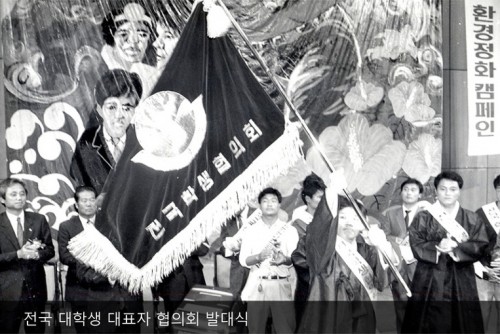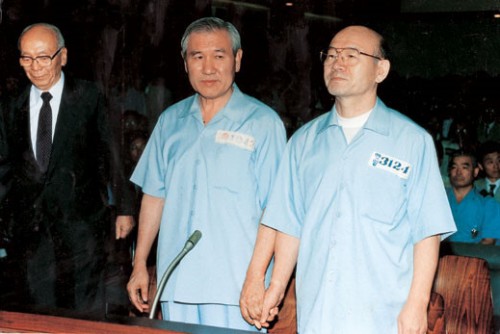The CNU May 18 Memorial Hall is a space to collect related material and remember and commemorate the accomplishments of the people of CNU, who participated in the democratization movement in Korea, which culminated in the May 18 Democratization Movement in 1980. In the May 18 Memorial Hall, about 1,000 valuable materials such as scripts of statements, flyers, meeting minutes, memos, books, photos, videos, relics of victims, and materials collected during the uprising, which belong to citizens, pro-democracy activists of Gwangju and professors from CNU.
In addition, the history of the CNU’s democratization movement from the 1960s to the 2000s can be viewed at a glance. Visitors can see and feel the activities and sacrifice of martyrs from CNU such as Kim Nam-joo, Yoon Sang-won, Park Kwan-hyeon, and Park Seung-hee, who dedicated themselves to the democratization movement. Although the May 18 Memorial Hall is a small space, it is a place full of memory and valuable learning where people can empathize with each other and appreciate May 18, which is often viewed differently between generations and regions.
1. Democracy and History Hall introduces records of major struggles and movements in which CNU students and professors participated from the 1960s to the present.
2. The May Hall is a space to reflect on the historical significance of the May 18 Democratization Movement by reproducing the development process of the May 18 Democratization Movement centering on photographs and materials.
3. The Martyrs for Democracy Hall is a place to understand and commemorate the lives of the martyrs of CNU who devoted their lives to democratization movements.
4. The Democracy Cinema Hall provides video records of the democratization movements, such as movies and videos.
5. The Democracy Arts Hall is a space for a special exhibition of materials and artworks related to the May 18 and democratization movements.
6. Archives Hall is a space where CNU stores, retrieves, and shares the achievements and monuments of its research on democratization movements.
Martial Law Expansion Measures and Sporadic Protests (1980. 5. 17. ~ 5. 18.)
emergency martial law expanded nationwide, Martial law army marching and student accompaniment to Gwangju city university
First clash between students and paratroopers at the main gate of Chonnam National University
On the afternoon, a paratrooper appeared at the Yudong three-way intersection and carried out a suppression operation.
549 citizens and students were arrested during the protest
Proliferation of protests against hard-line repression (1980. 5. 19. ~ 5. 20.)
Citizens began to gather in downtown Gwangju. 11th Airborne Brigade deployed to Gwangju
About 30 men and women were beaten while wearing only underwear in front of the Catholic Center on the morning, The battle between airborne troops and citizens continues
In the afternoon, about 200 taxis turned on their headlights and raised their horns and held a vehicle demonstration.
In the evening, the MBC building in Gwangju was set on fire.
Mass firing of martial law forces and armed uprising (1980. 5. 21.)
In the morning, the paratroopers who received live ammunition are placed in front
When the national anthem is sounded from the wiretap speaker, the paratroopers start firing
Citizens drag dozens of military trucks and armored vehicles out of an Asian car factory
Protesters who acquired weapons in the Hwasun and Naju areas engage in a street battle in front of the provincial government, Paratroopers withdrew to the outskirts of the city in the afternoon.
Liberation Gwangju, Civil Autonomous Community (1980. 5. 22. ~ 5. 26.)
Establishment of Citizens Appropriation Countermeasures Committee
Hold 18 corpses enshrined in the Provincial Government Plaza
Briefing on the situation in Gwangju to foreign correspondents, spokesperson for the Student Probation Committee
Citizens' Army, Officially Announced "There is a high probability that martial law forces will invade tonight“
Armed Suppression and Battle for Decision (1980. 5. 27.)
Entering the city of martial law with tanks at dawn
Complete siege around the provincial government building at dawn
At dawn, the martial law forces, including the provincial government, took control of the entire city and ended the suppression operation.
The end of the protest by the armed suppression of martial law forces at dawn
University Deprived of Liberty
As indicated by the student guidance guidelines for the prevention of protests, universities in the 1980s completely lost their freedom and autonomy. University faculty and staff were forced to monitor, and control students and the school authorities were encouraged to classify and supervise students who were likely to participate in protests.
Democratization Movement for Succession of the May 18 Democratization Movement
In the 1980s, the CNU campus became the stage of numerous protests and demonstrations for various goals such as uncovering the truth of the May 18 Democratization Movement and finding out who is responsible for the massacre, democratizing the university system, releasing and reinstating detained students, an apology from the United States for condoning the Gwangju Massacre, and consideration for the socially disadvantaged such as workers and peasants. In addition, when Park Gwan-hyeon, president of CNU's Student Council, died after being arrested in 1982, the fiercest anti-government struggle since the May 18 Democratization Movement took place in CNU and Gwangju. Every October, the memorial demonstration for the martyr Park Gwan-hyeon has become an annual event in the university district.
The Resurrection of Student Council
In 1984, CNU students formed the Hakjachu, an initiative for academy democratization (which was later renamed the Democratic Recovery Promotion Committee) to democratize the university. In 1985, the student council was launched by the direct system instead of the Hakdohogook group, a student group whose primary goal is to defend the government and Oh Byung-yun was elected as the student council president.
▶ In 1985, organizations for protest and organization for national solidarity were launched
Democratization Movement after the June 1987 Democratic Uprising
Aspirations for direct constitutional amendment and democratization abrupted as a nationwide democratization movement in June 1987 as students and citizens witnessed the torture and death of Park Jong-cheol, President Chun Doo-hwan's April 13 constitutional measures to resist amendment and Lee Han-yeol's death by tear gas gun. In the end, Democratic Party candidate Roh Tae-woo gave in to the people's demands for democratization and announced the June 29 Declaration that accepted the direct constitutional amendment. With Lee Han-yeol's burial at the Mangwol-dong graveyard, Gwangju became a sacred place for democratization, where the victims of the national democratization movement hoped for their burial.
Democratization Movement after the June Uprising
After the June Uprising in 1987, democratization movements in Korea became more intense not only in politics, but also in education, labor, and culture. The democratization forces did not slow the reins of the democratization movement, hoping for the truth about the 5/18th, punishment of those responsible, reconciliation and peaceful reunification of the two Koreas, improvement of the people's quality of life, and the coming to power of democratization forces.
Student Organization after the June 1987 Democratic Uprising

After the June 1987 Democratic Uprising, the National Association of College Student Representatives (Jeondaehyup) was launched as a national organization that led the student movement. In its inauguration declaration, the Jeondaehyup set out its goals of the establishment of an independent democratic government, peaceful reunification of the country, people's solidarity, independence of academies, and the unity of one million students. Simultaneously with the inauguration of Jeondaehyup, university students from Gwangju and South Jeolla Province formed the Chonnam Regional University Student Representative Council (Namdaehyup). The Jeondaehyup was changed to the Korea University Student Association (Hanchongryun) in 1993.
South Jeolla Province Has Emerged as the Center of the National Student Movement
After the June 1987 Democratic Uprising, the main agenda for CNU's student movement was for democracy, anti-Americanism, unification, and solidarity movement for the socially underprivileged and it was at the center of the national students’ movement. Many served as representatives of national student organizations.
Fierce Student Struggle and the Self-Sacrifice of Park Seung-hee
After the June 1987 Democratic Uprising, the main agenda for CNU's student movement was for democracy, anti-Americanism, unification, and solidarity movement for the socially underprivileged and it was at the center of the national students’ movement. Many served as representatives of national student organizations.
Professors in Democratization Movement
After the June 1987 Democratic Uprising, CNU was the second in the country to secure the direct electoral system for the presidential election as a part of university democratization. In addition, a faculty council was formed to promote the democratization of academies. At the same time, a nationwide democratic faculty organization called the National Faculty Association for Democratization (Minkyohyup) emerged.
CNU Professors’ Declaration of State
CNU professors have published a declaration of state at an important moment in the process of democratization.
- In April 1986, professors issued a declaration titled “Our Opinion,” calling for democratization and autonomy of universities.
- In June 1986, 265 professors from 23 universities across the country, including professors from CNU, issued a declaration stating, “We Once Insist Our Will,” urging the enactment of a democratic constitution.
Political Democratization

The long history of the democratization movement led to the overthrow of authoritarian regimes and the establishment of a democratic government. 16 years after the May 18 Democratization Movement, former presidents Chun Doo-hwan and Roh Tae-woo were brought to justice on charges of corruption and rebellion.
Institutionalization of Democracy
The movement to enact a special act on May 18 has been one of the main goals of the democratization movement since the 1980s. In 1995, the Special Act on the May 18 Democratization Movement was enacted and the honor of Gwangju citizens was restored. Also, in 1997, May 18 was established as the Gwangju Democratization Movement Day and advanced institutional measures were prepared for the promotion of human rights, such as the establishment of the National Human Rights Commission and the Clarification Commission for Suspicious Death.
A Big Step in the Unification Movement
The democratization activists set unification as another important task in addition to political democratization. The unification movement made great progress with the inter-Korean summit on June 15, 2000. The two leaders of the two Koreas reached an agreement and signed the Inter-Korean Joint Declaration to transform the basic framework of inter-Korean relations, which had been riddled with confrontation and antagonism, into peaceful coexistence, reconciliation, and cooperation.
Changes in the Democratization Movement
As the removal of oppression in the life of people became the new goal of the civic society next to the democratization movement, new movements such as women's rights, peace, human rights, culture and arts, minorities, and environmental movements as well as workers' and peasant movements have emerged, expanding the horizon of democracy. Now, the democratization movement will be sublimated into a new principle that determines the life of people.